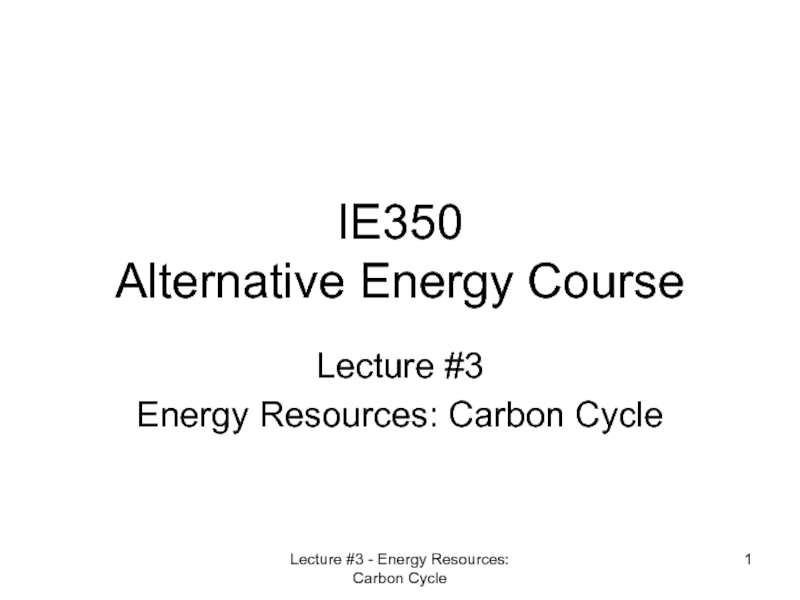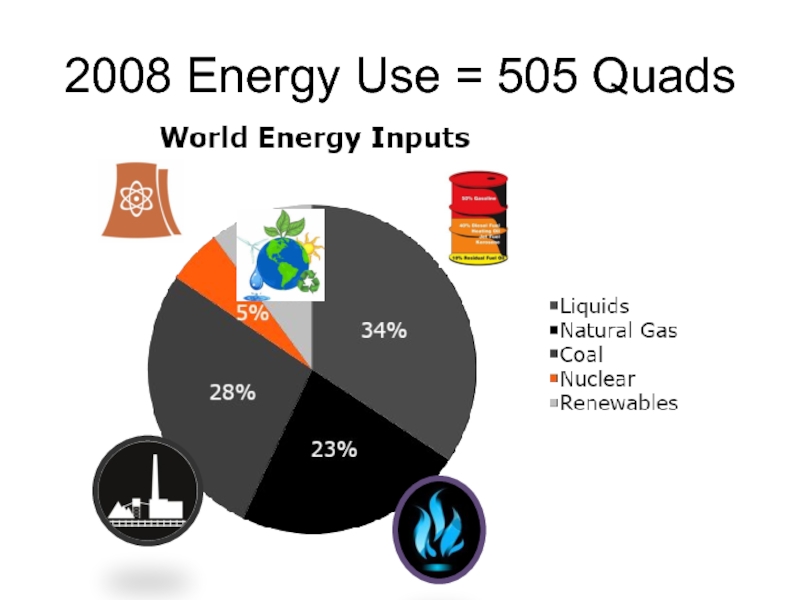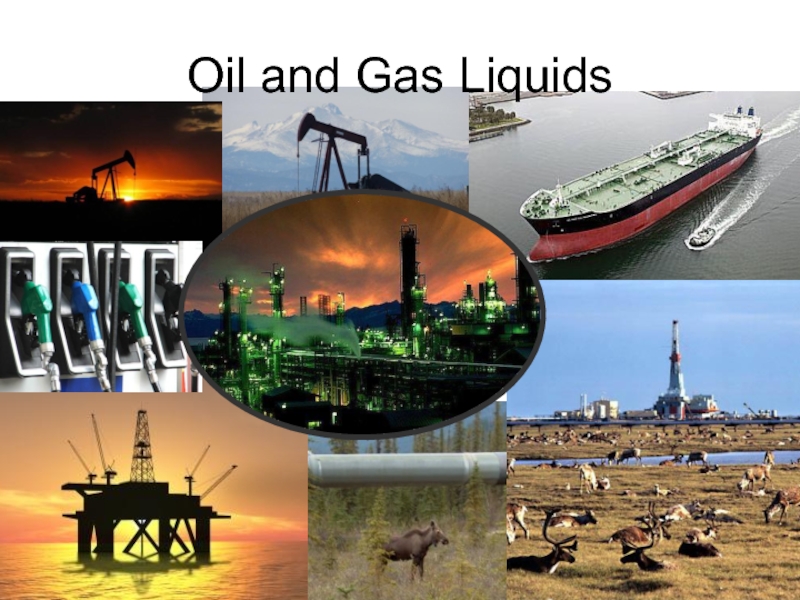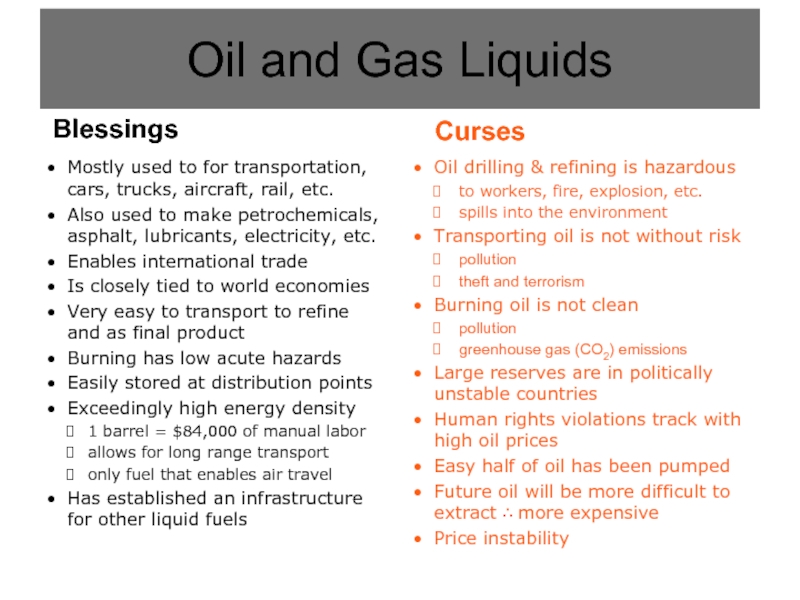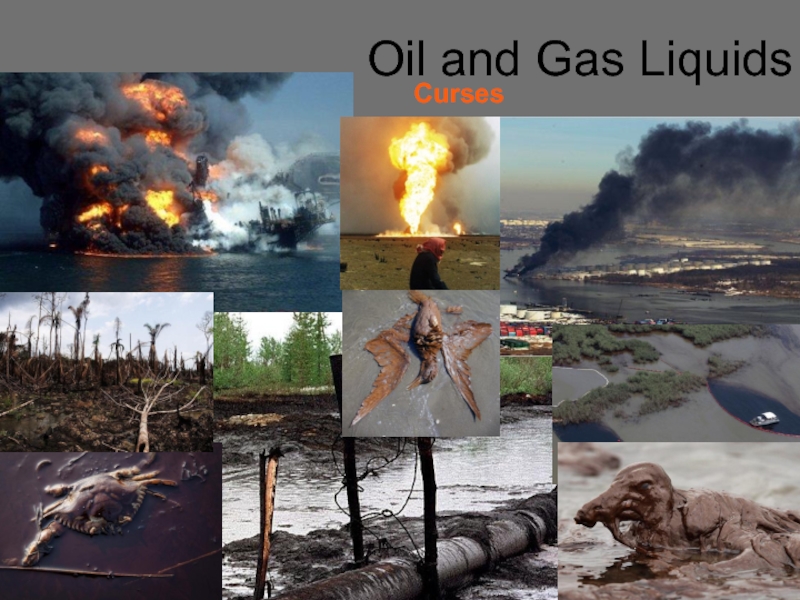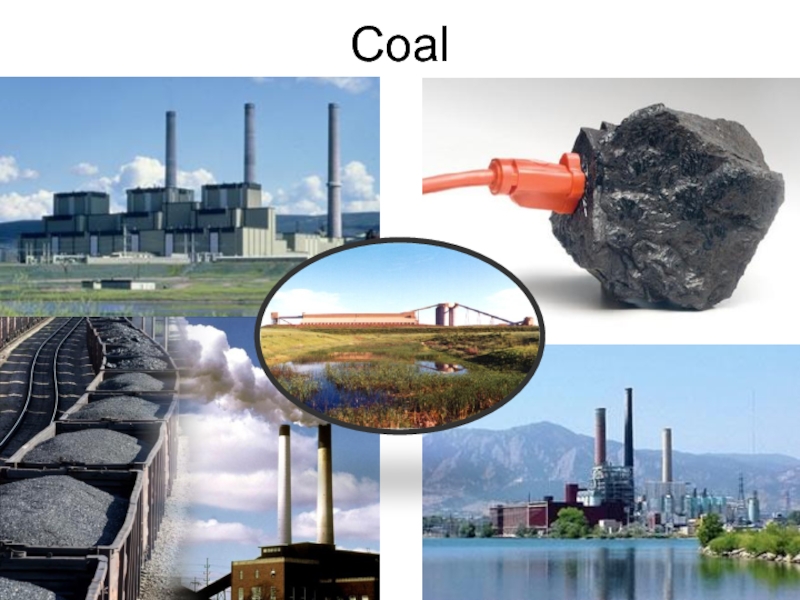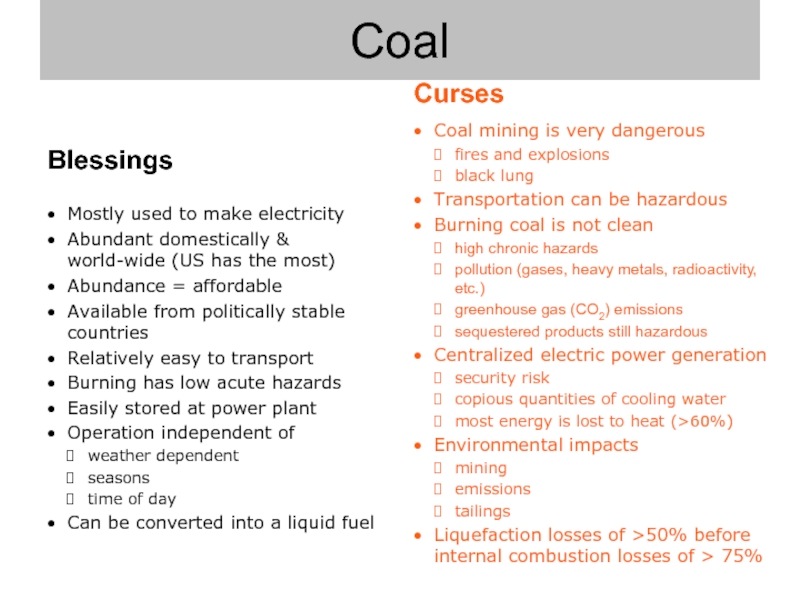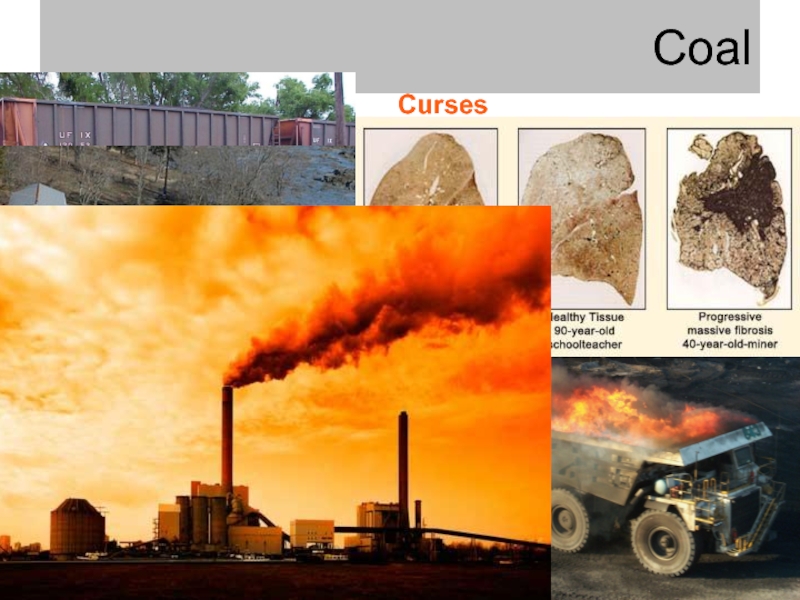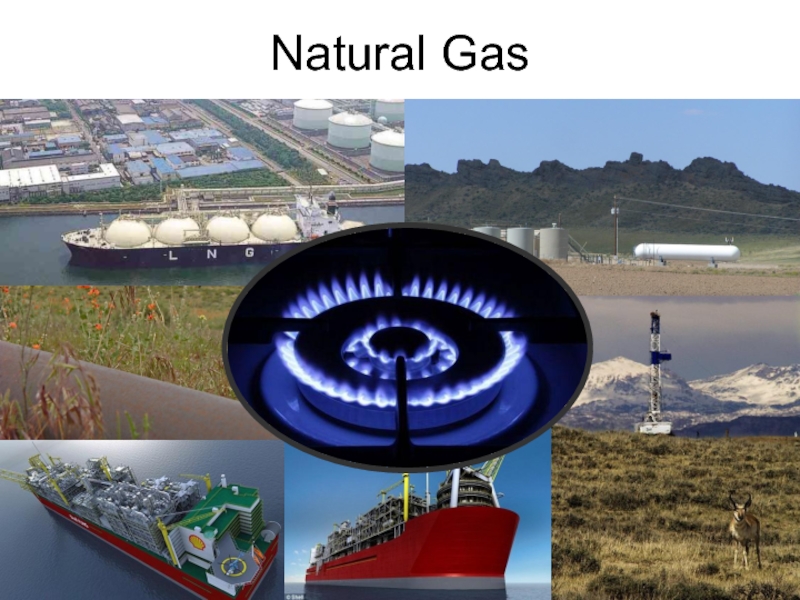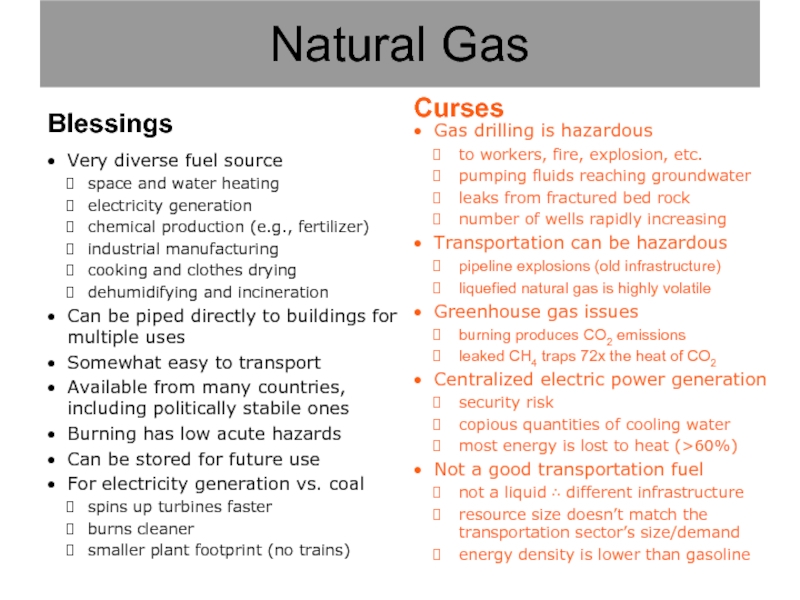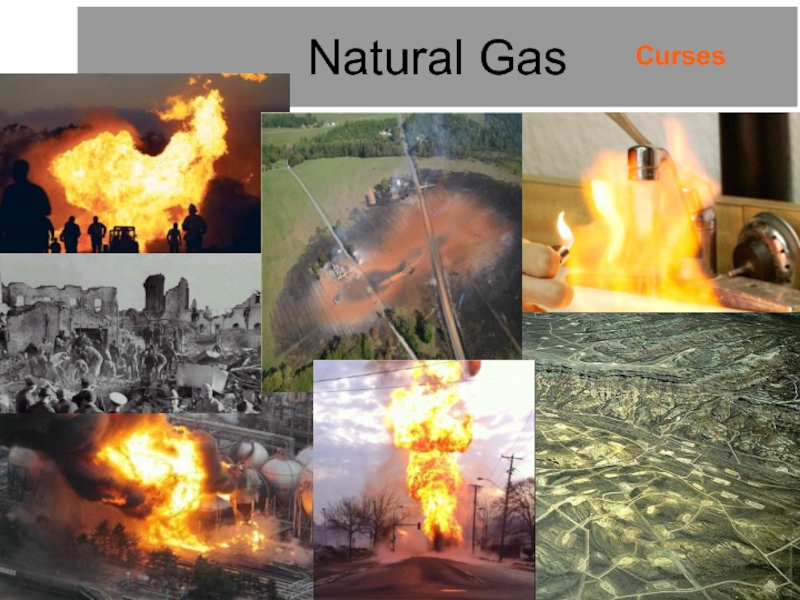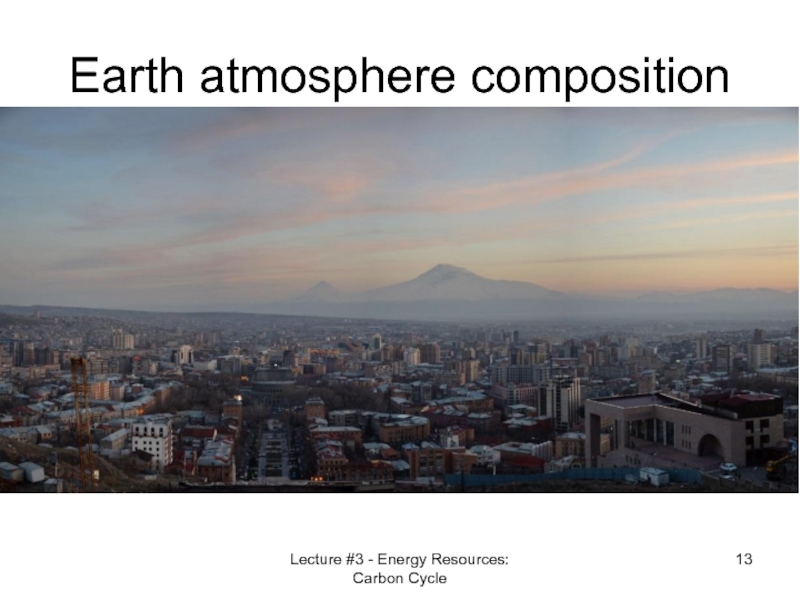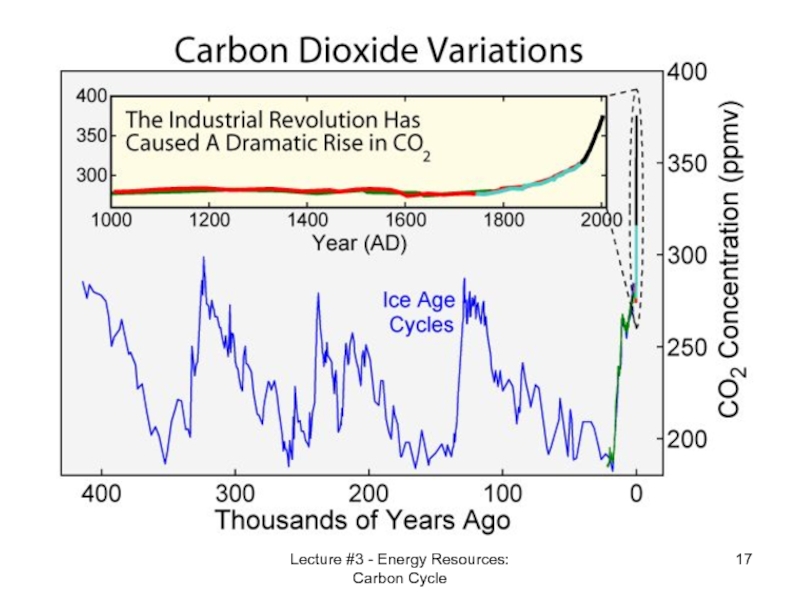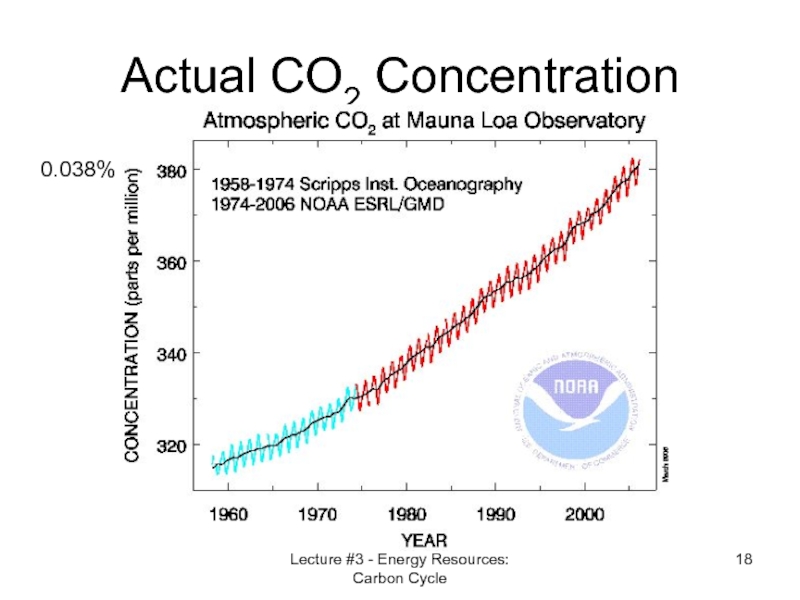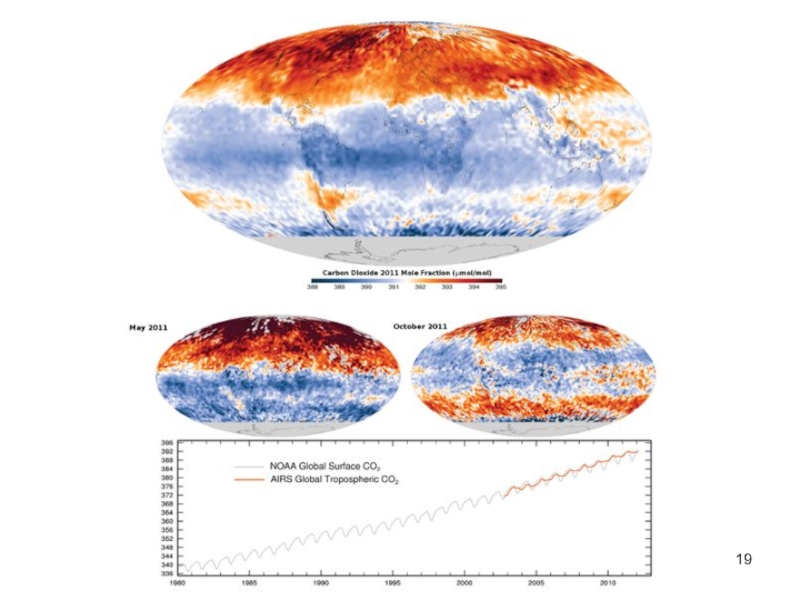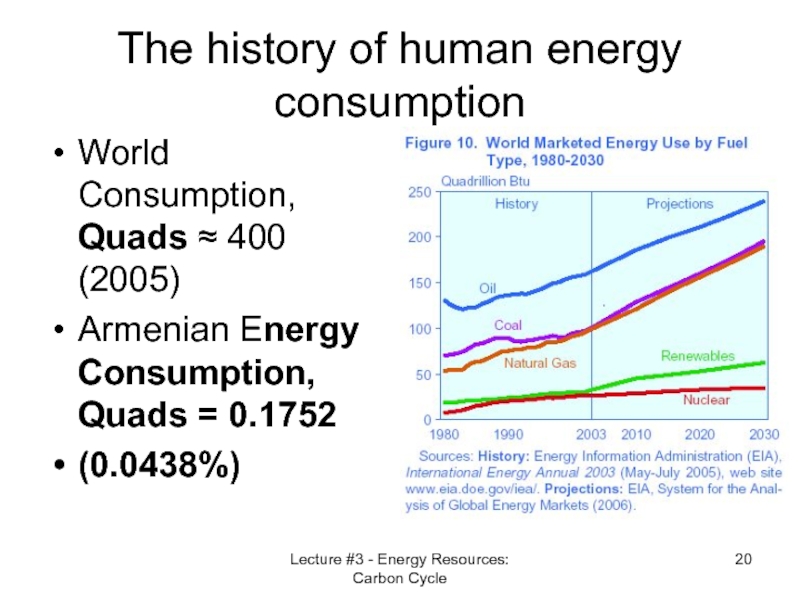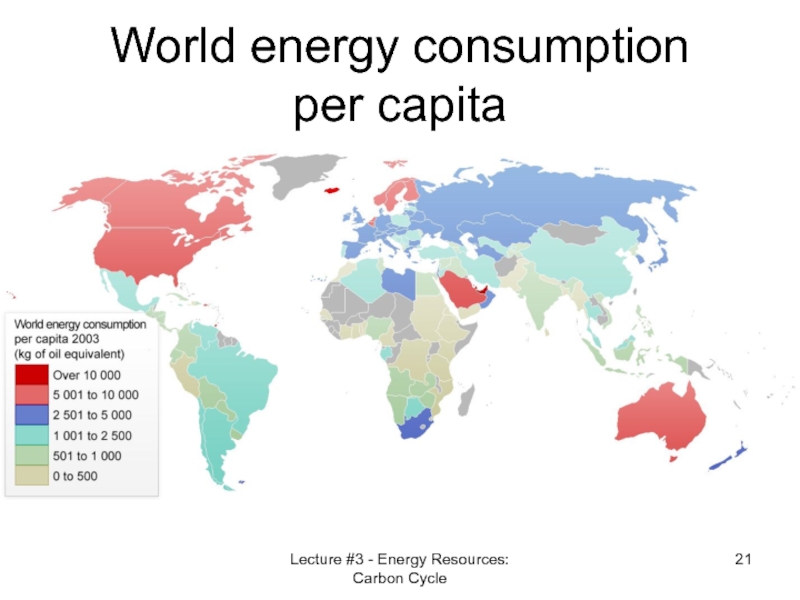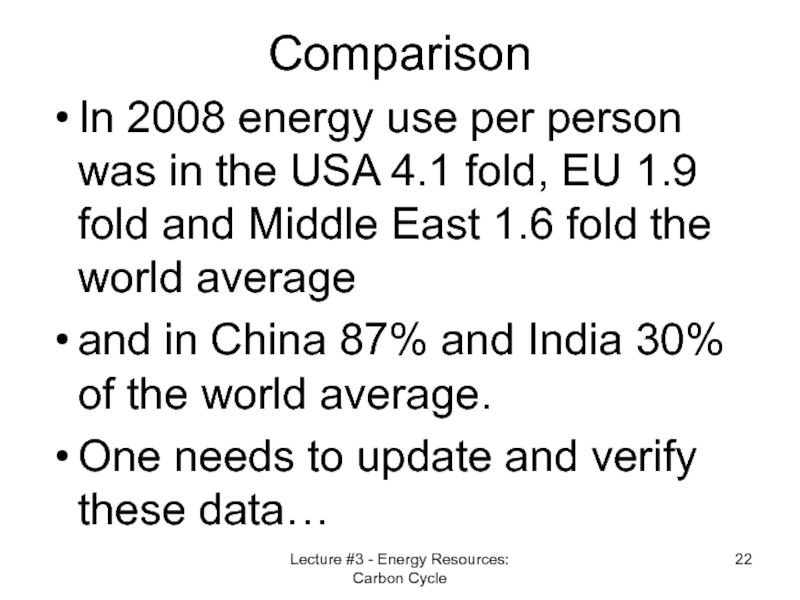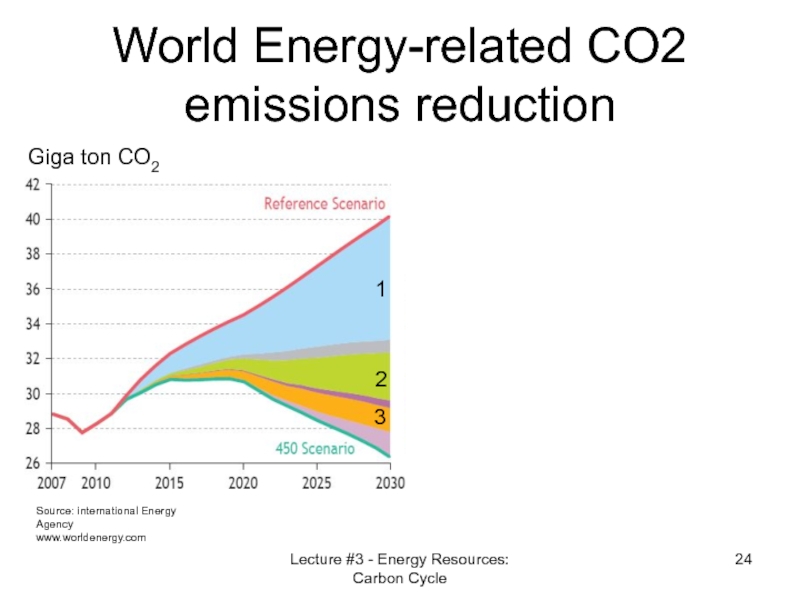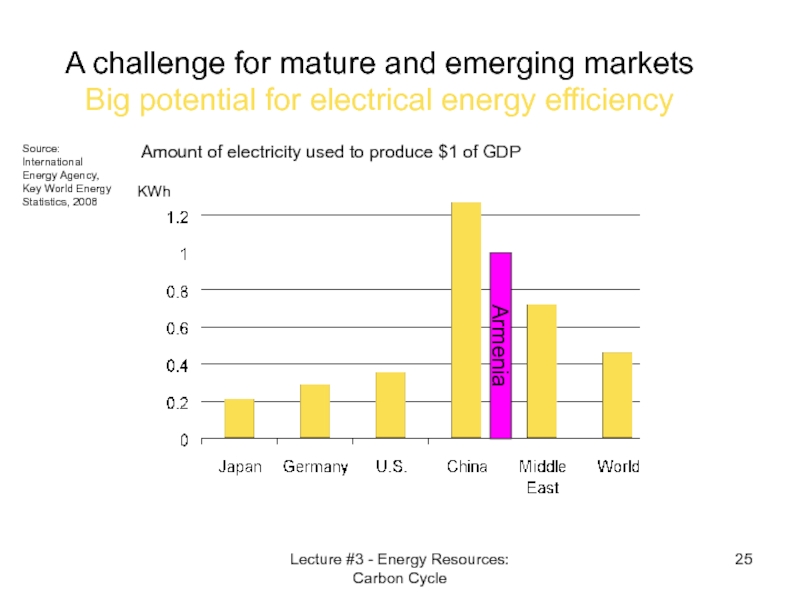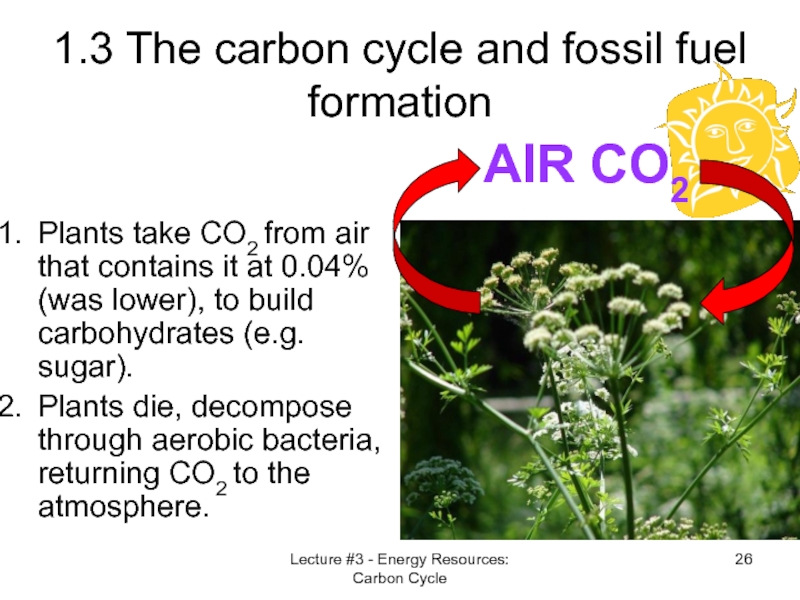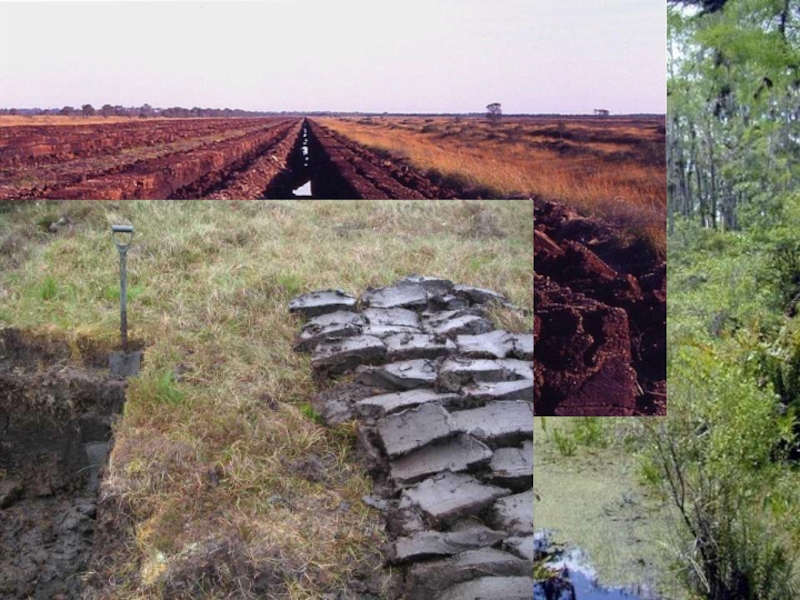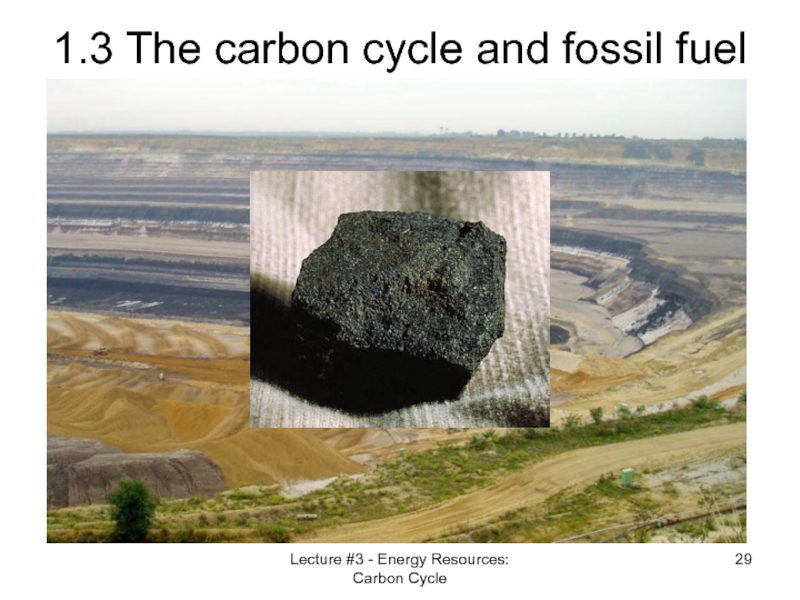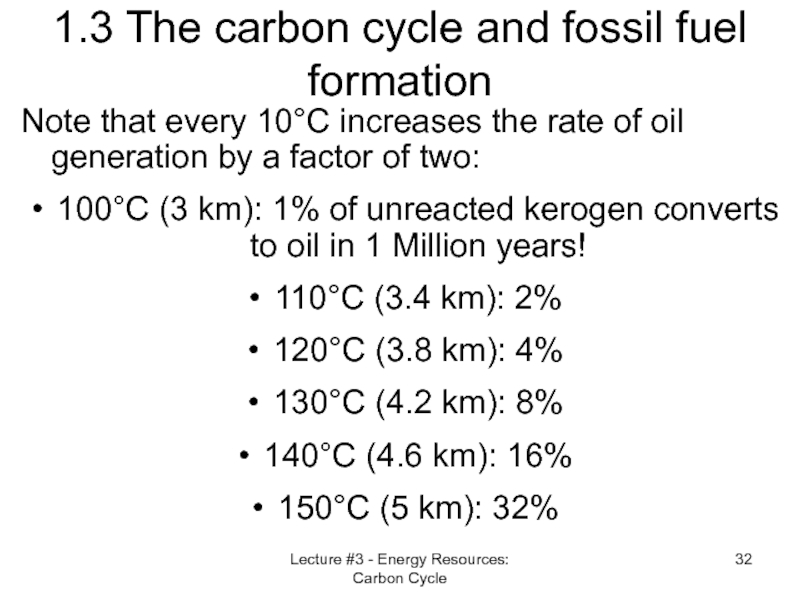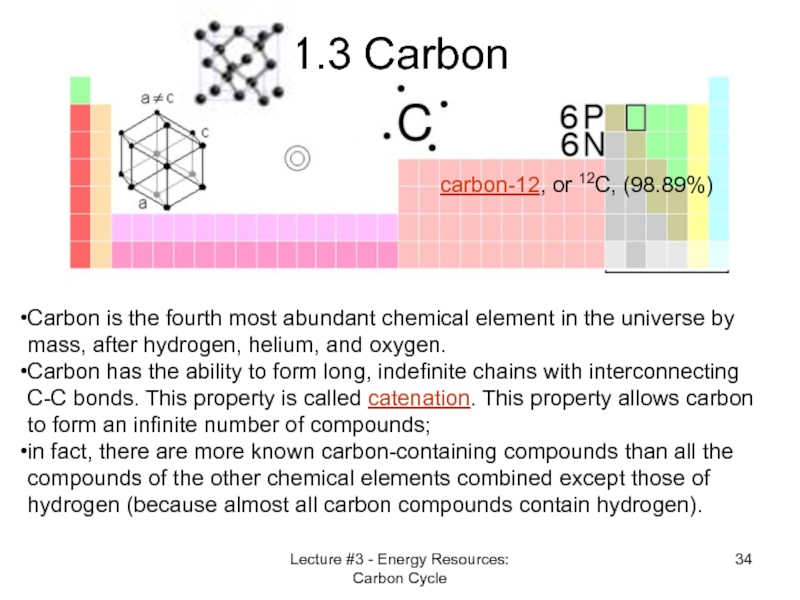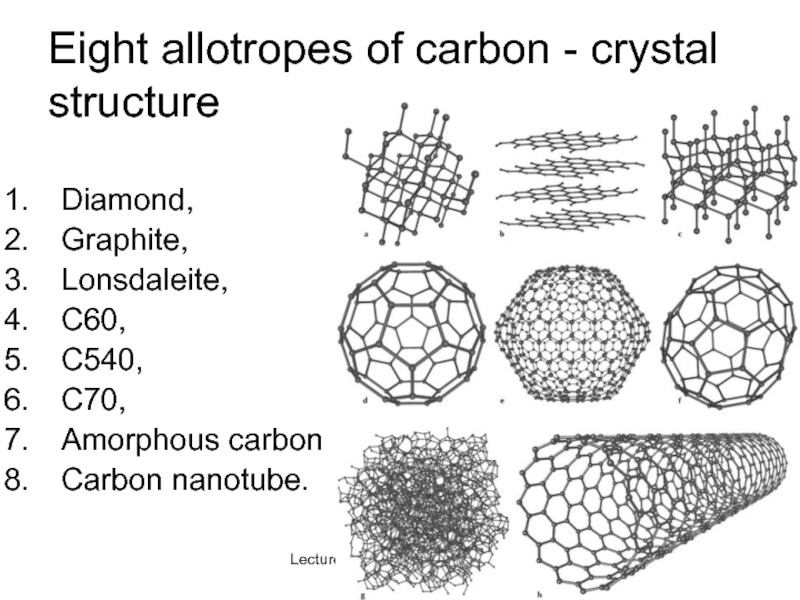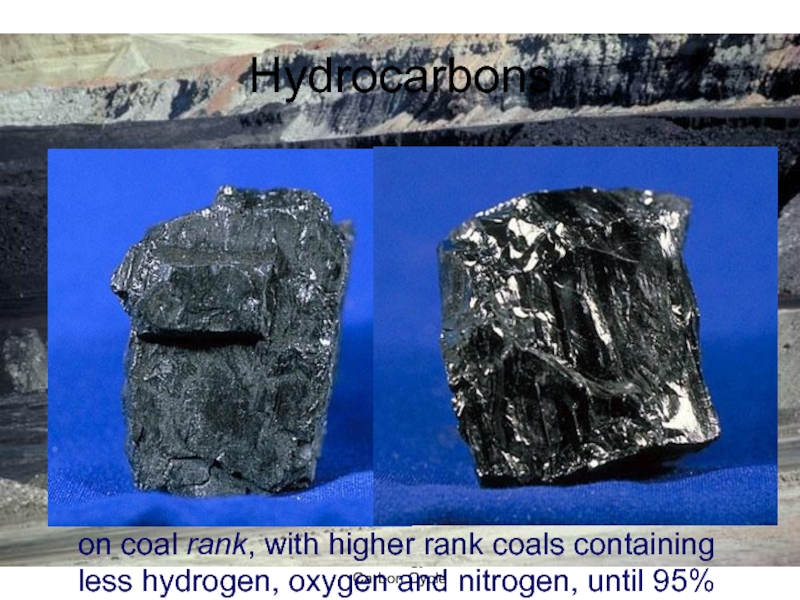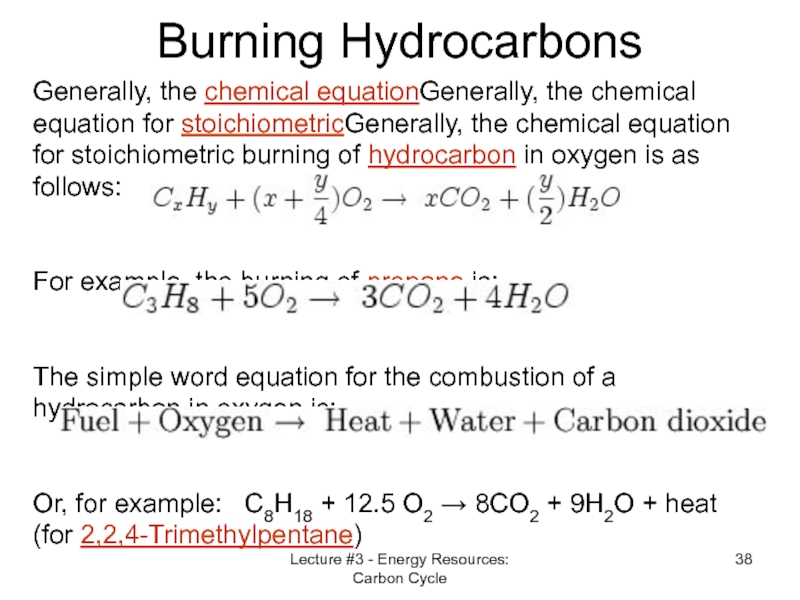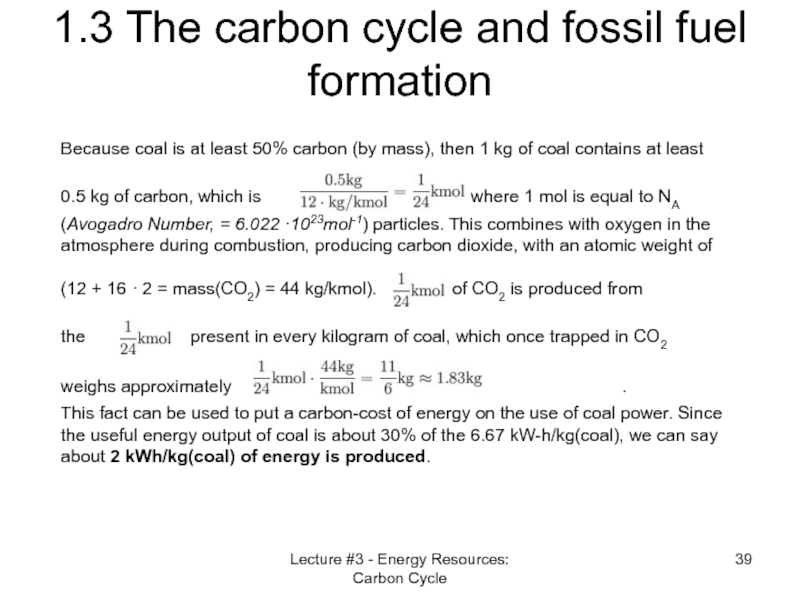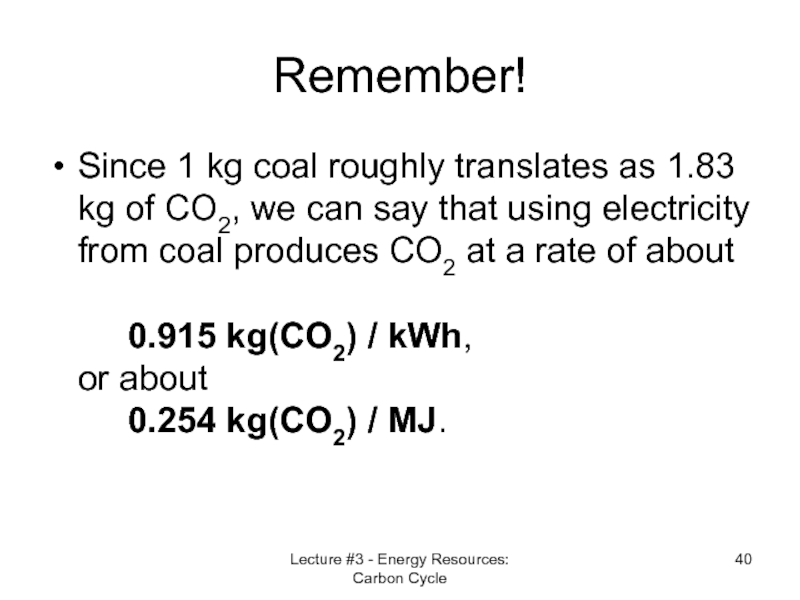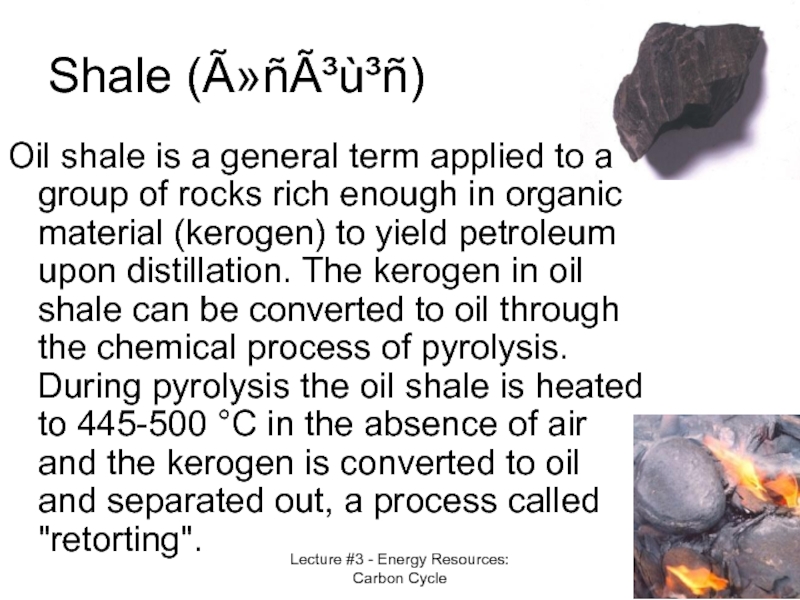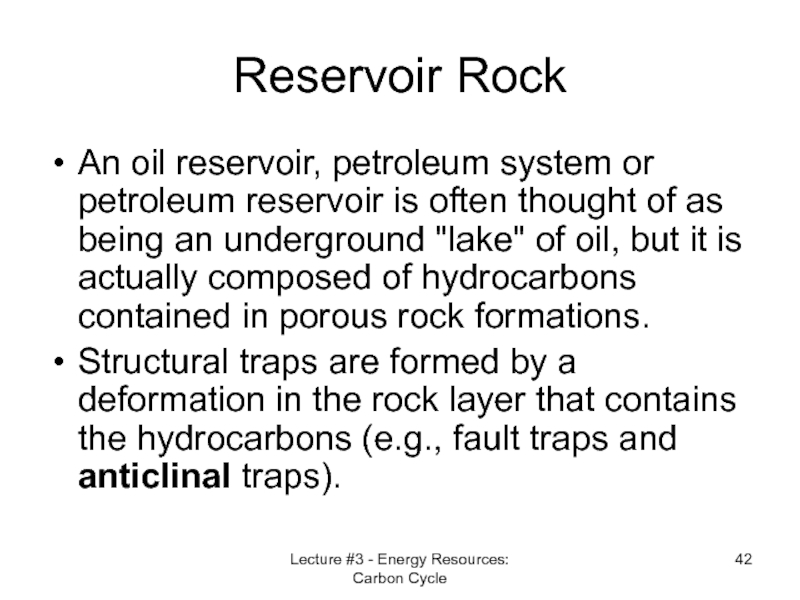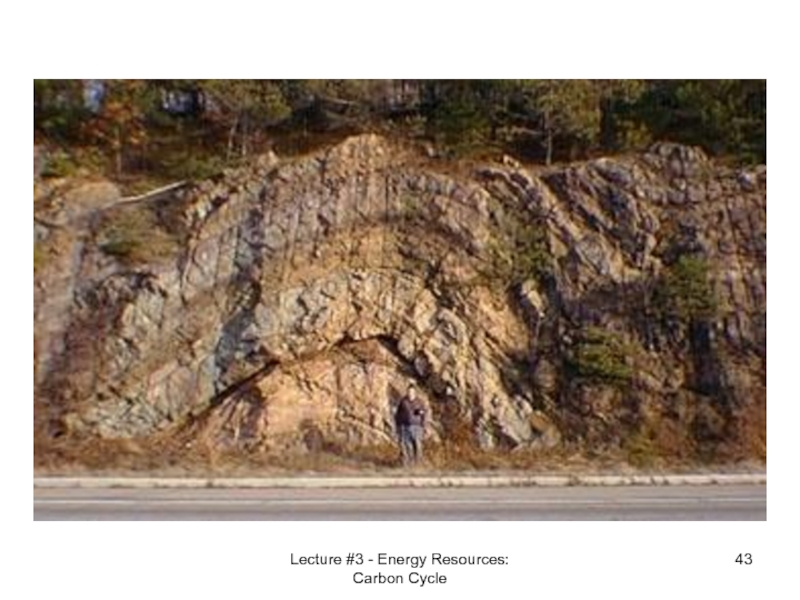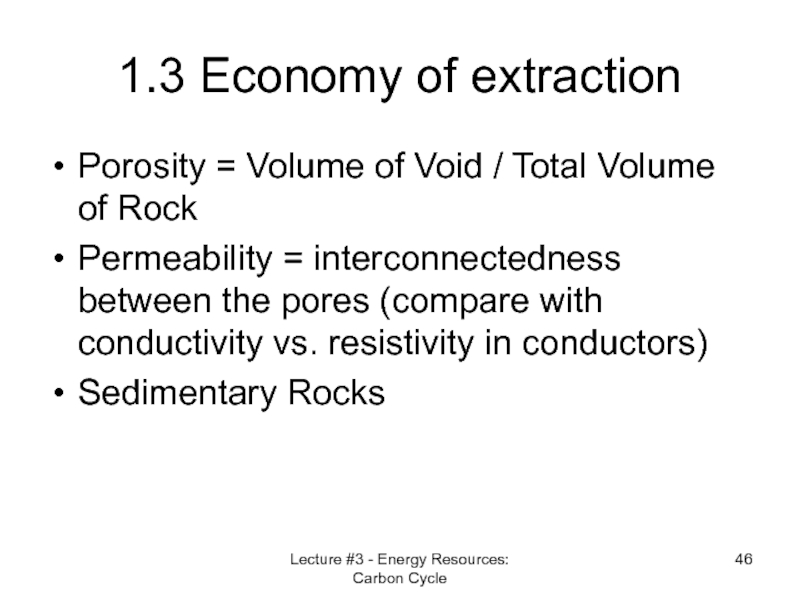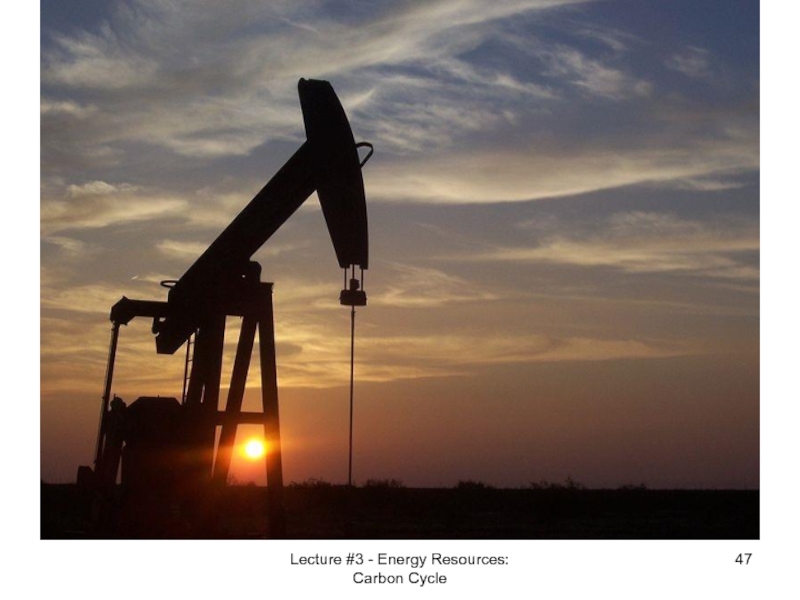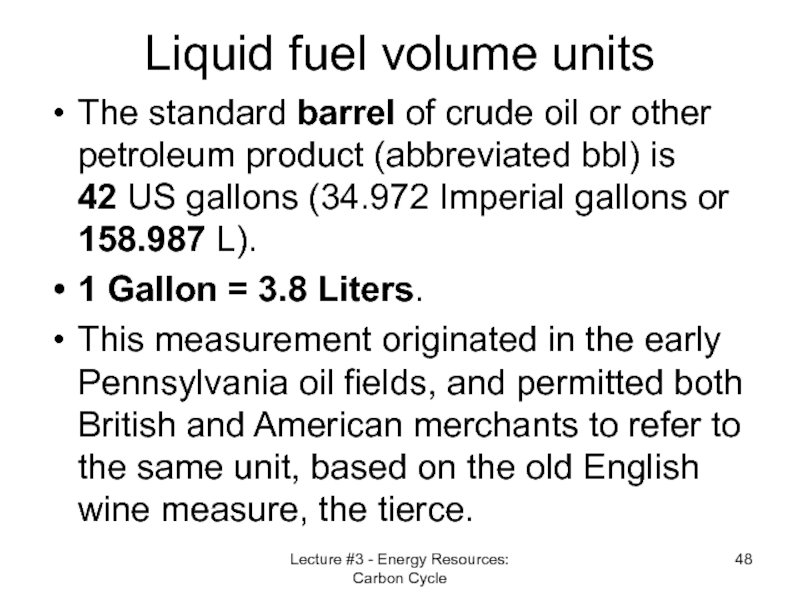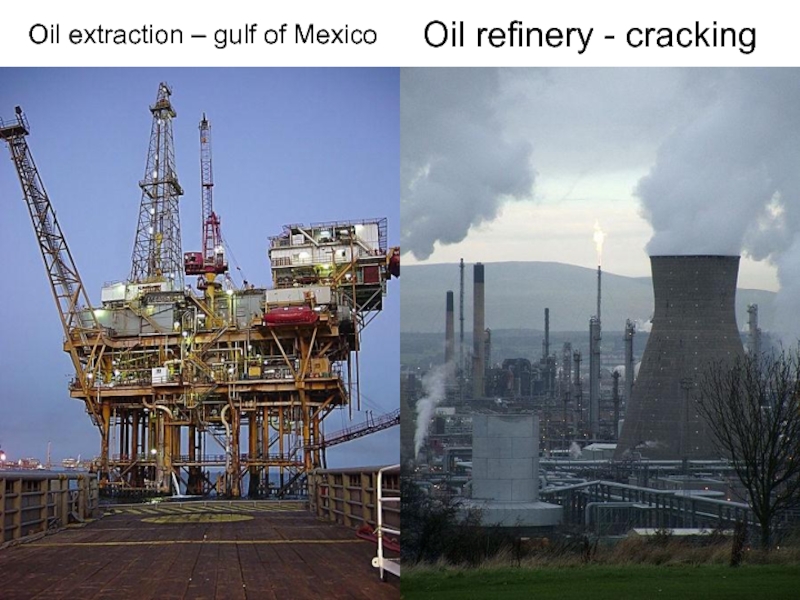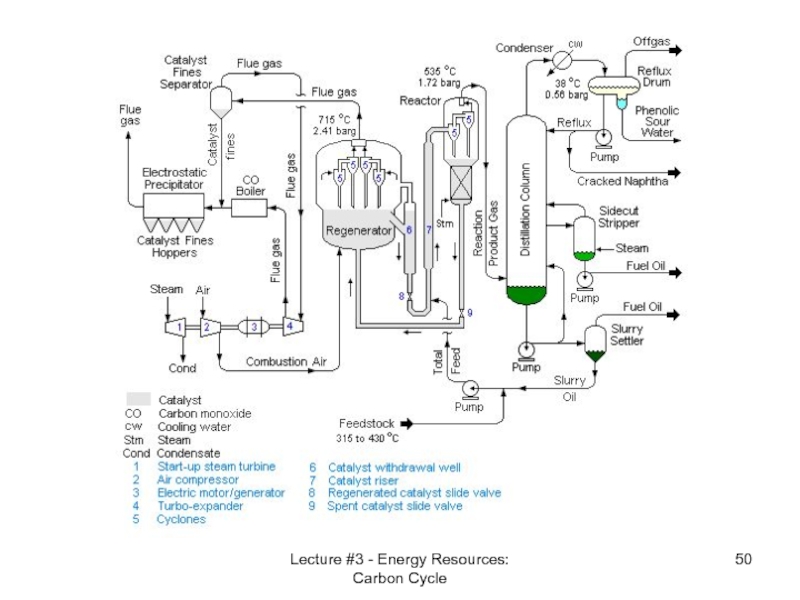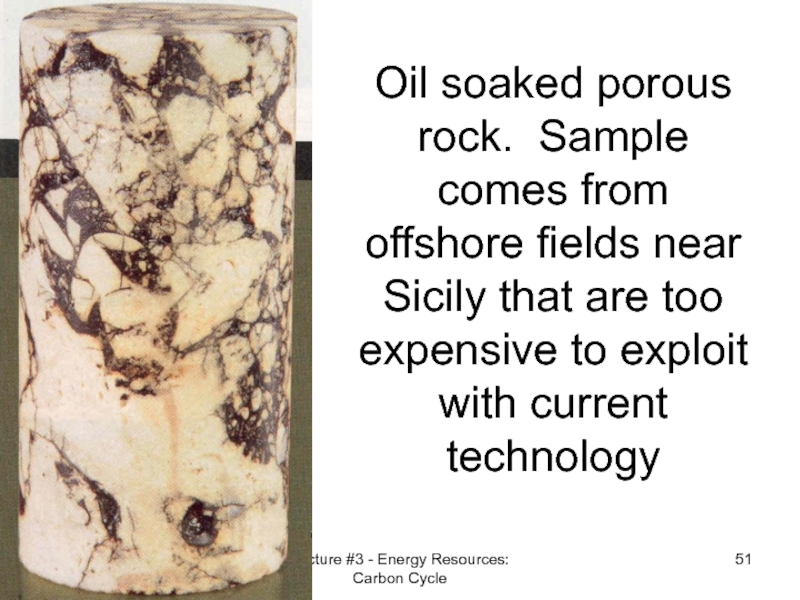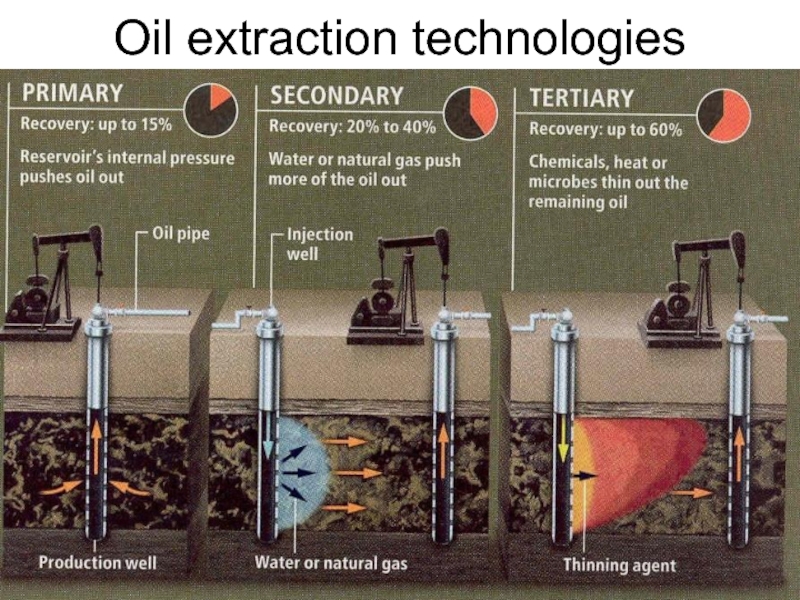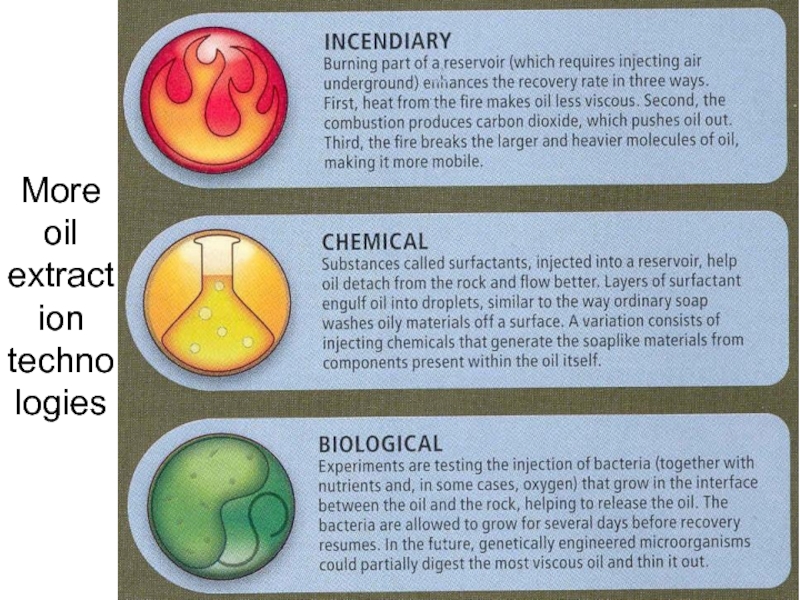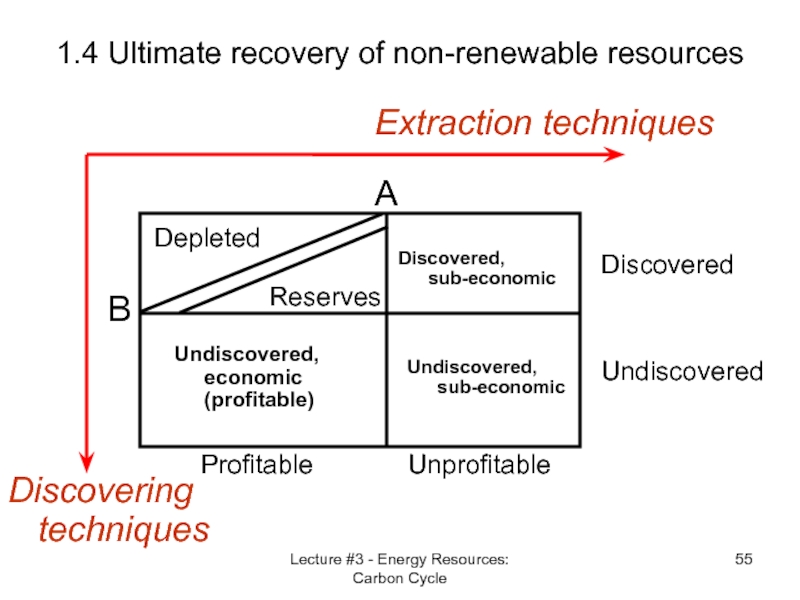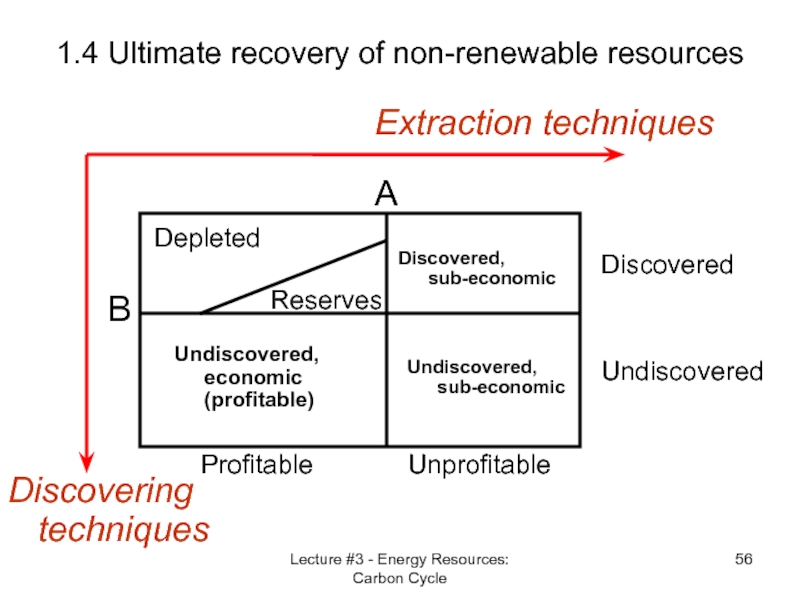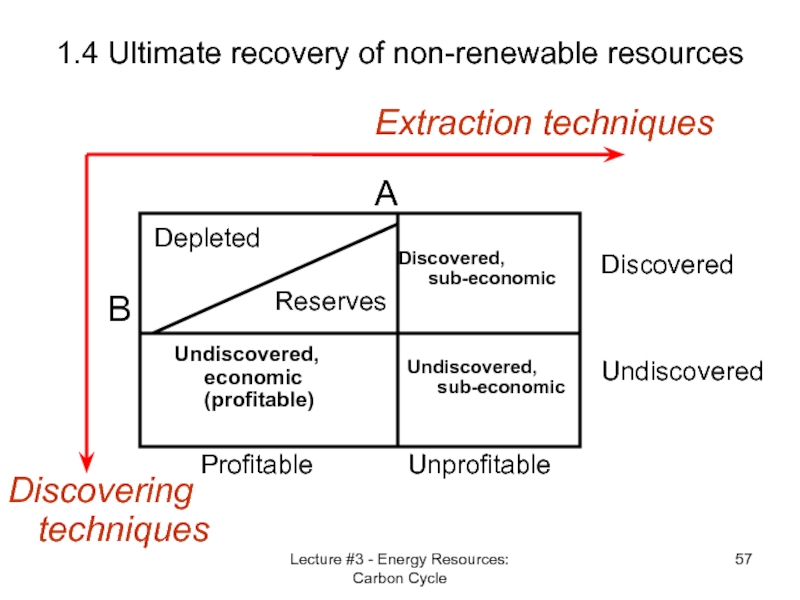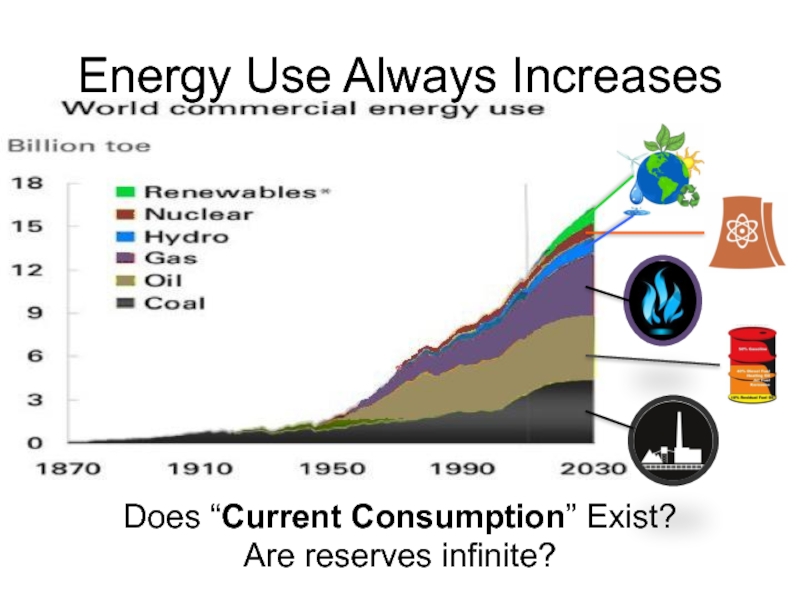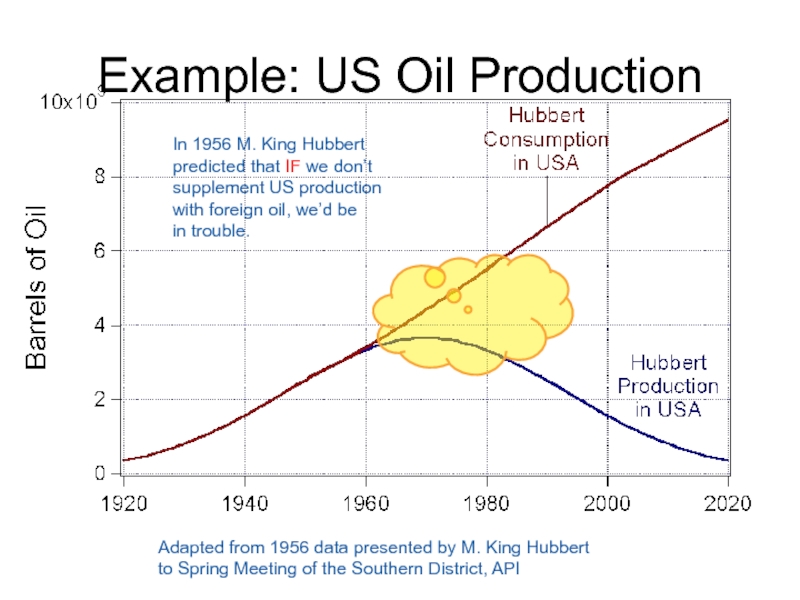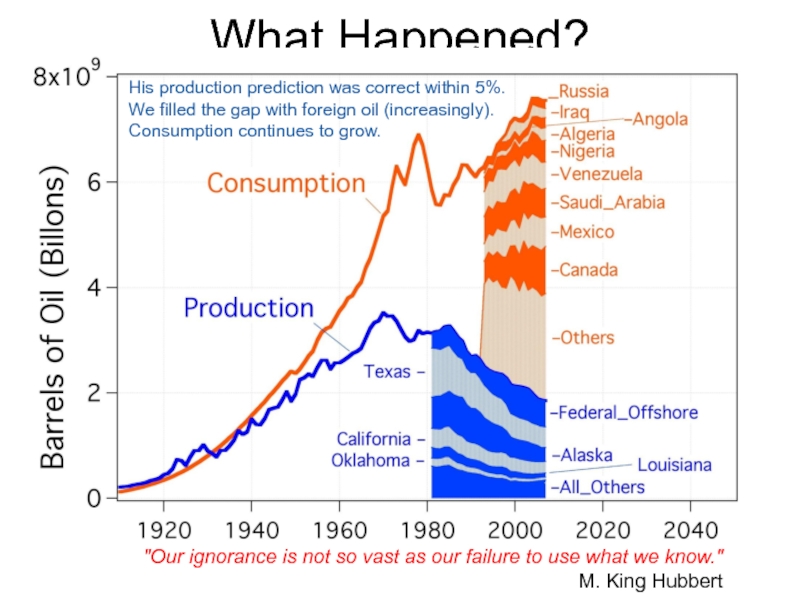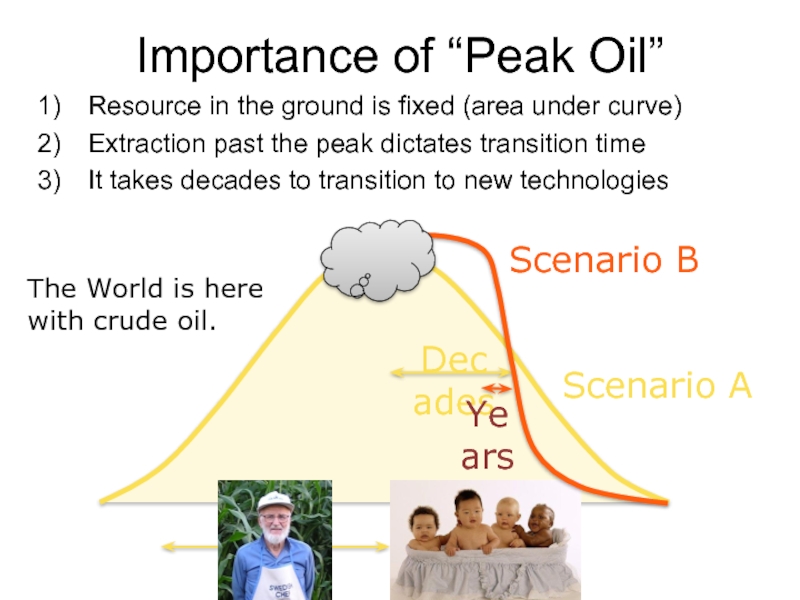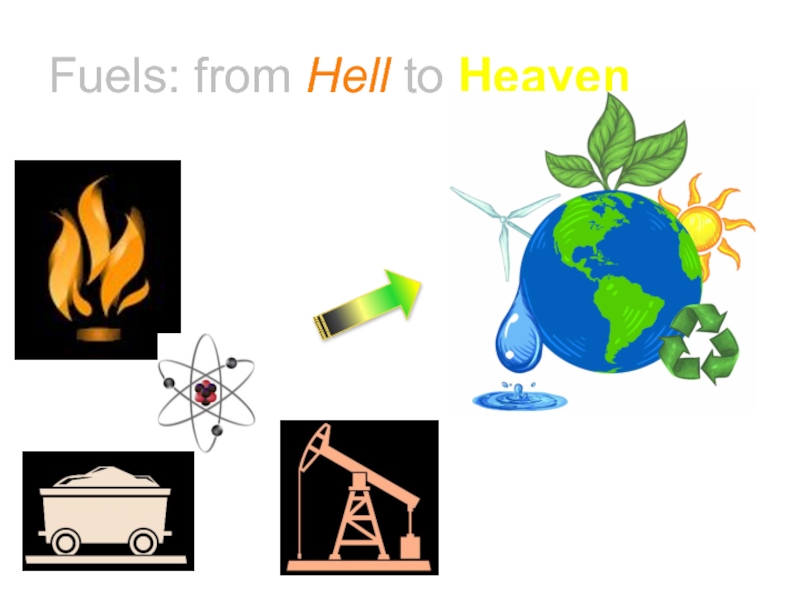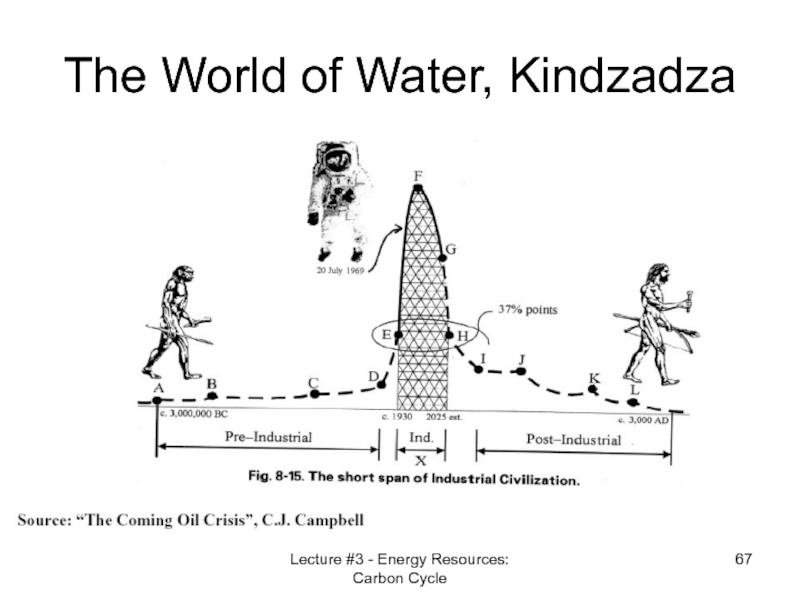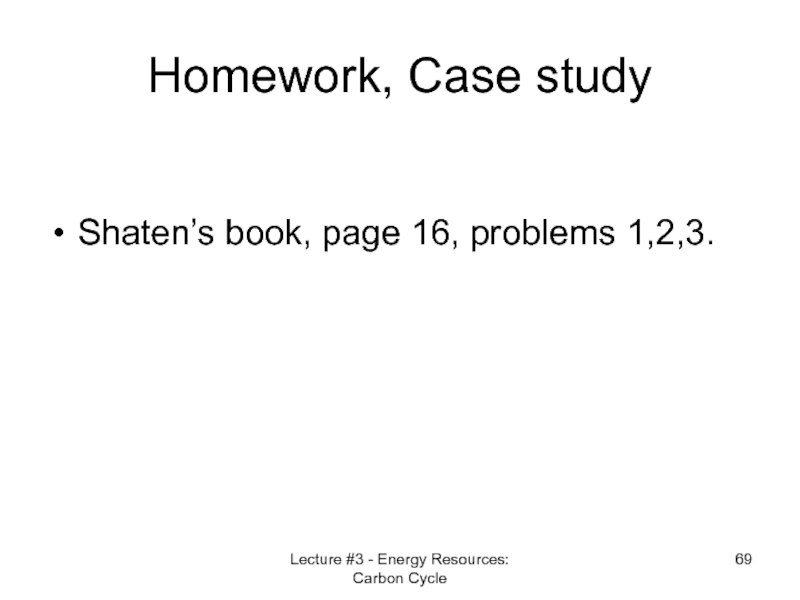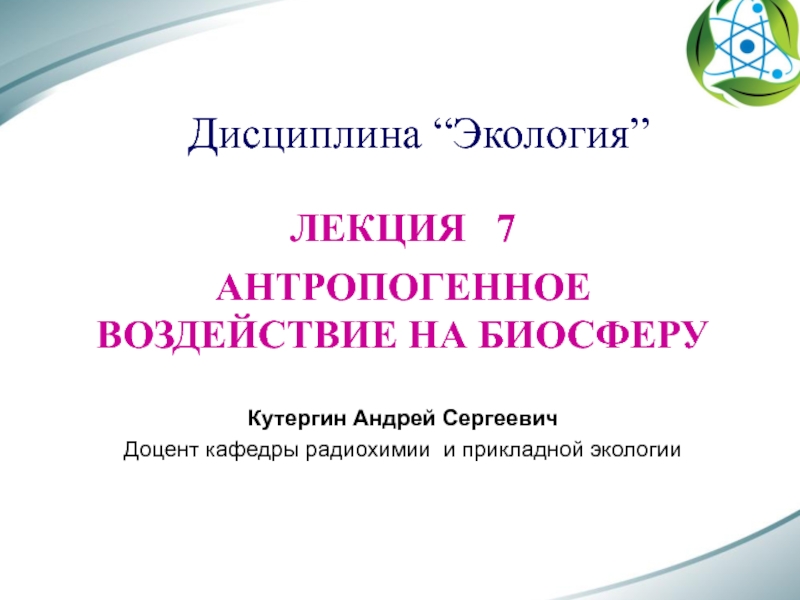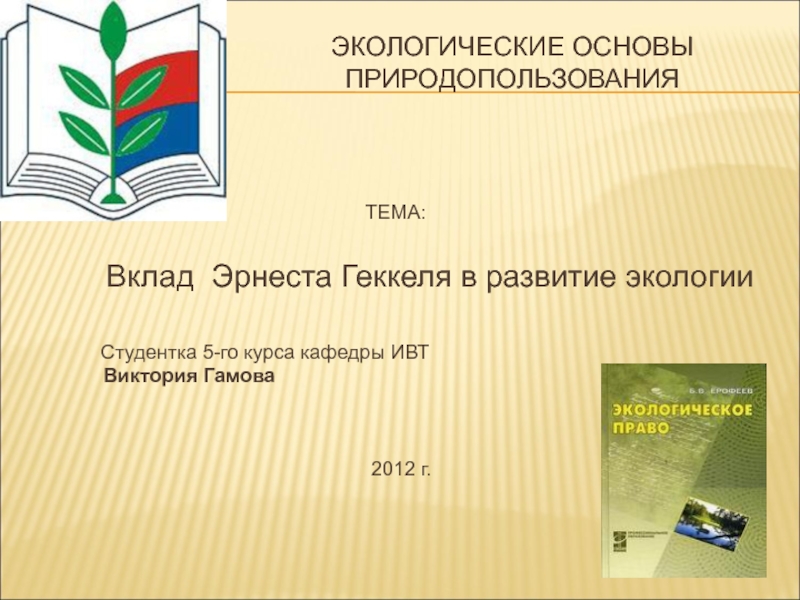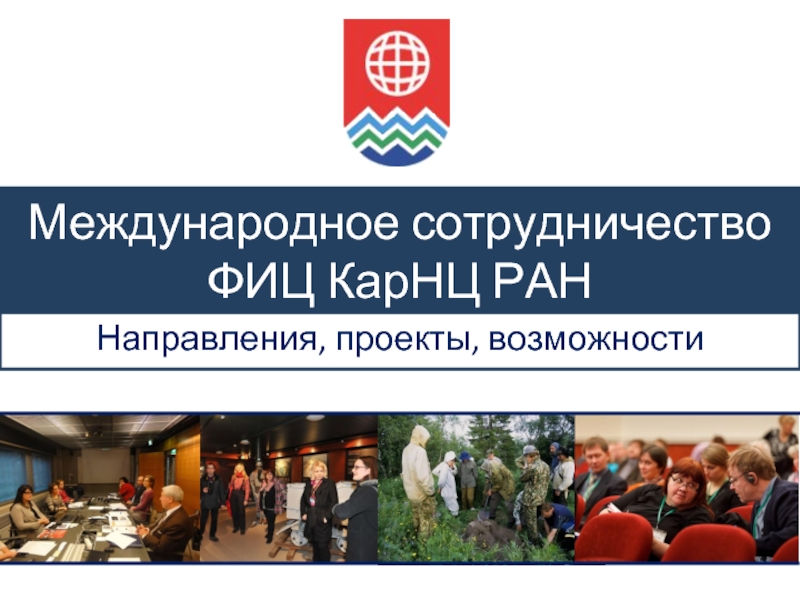- Главная
- Разное
- Дизайн
- Бизнес и предпринимательство
- Аналитика
- Образование
- Развлечения
- Красота и здоровье
- Финансы
- Государство
- Путешествия
- Спорт
- Недвижимость
- Армия
- Графика
- Культурология
- Еда и кулинария
- Лингвистика
- Английский язык
- Астрономия
- Алгебра
- Биология
- География
- Детские презентации
- Информатика
- История
- Литература
- Маркетинг
- Математика
- Медицина
- Менеджмент
- Музыка
- МХК
- Немецкий язык
- ОБЖ
- Обществознание
- Окружающий мир
- Педагогика
- Русский язык
- Технология
- Физика
- Философия
- Химия
- Шаблоны, картинки для презентаций
- Экология
- Экономика
- Юриспруденция
IE350 Alternative Energy Course презентация
Содержание
- 1. IE350 Alternative Energy Course
- 2. Your homework -3 use a more appropriate
- 3. 2008 Energy Use = 505 Quads
- 4. Oil and Gas Liquids
- 5. Oil drilling & refining is hazardous to
- 6. Mostly used to for transportation, cars, trucks,
- 7. Coal
- 8. Coal mining is very dangerous fires and
- 9. Mostly used to make electricity Abundant domestically
- 10. Natural Gas
- 11. Gas drilling is hazardous to workers, fire,
- 12. Gas drilling is hazardous to workers, fire,
- 13. Earth atmosphere composition Lecture #3 - Energy Resources: Carbon Cycle
- 14. Lecture #3 - Energy Resources: Carbon Cycle
- 15. Global Warming Potential - GWP Lecture #3
- 16. Lecture #3 - Energy Resources: Carbon Cycle
- 17. Lecture #3 - Energy Resources: Carbon Cycle
- 18. Lecture #3 - Energy Resources: Carbon Cycle Actual CO2 Concentration 0.038%
- 19. Lecture #3 - Energy Resources: Carbon Cycle
- 20. Lecture #3 - Energy Resources: Carbon Cycle
- 21. World energy consumption per capita Lecture #3 - Energy Resources: Carbon Cycle
- 22. Comparison In 2008 energy use per person
- 23. Primary energy Transport Generation T&D Industrial processes
- 24. World Energy-related CO2 emissions reduction Source: international
- 25. Amount of electricity used to produce $1
- 26. Lecture #3 - Energy Resources: Carbon Cycle
- 27. Lecture #3 - Energy Resources: Carbon Cycle
- 28. Lecture #3 - Energy Resources: Carbon Cycle Here geological times are involved
- 29. Lecture #3 - Energy Resources: Carbon Cycle 1.3 The carbon cycle and fossil fuel formation
- 30. Lecture #3 - Energy Resources: Carbon Cycle
- 31. Lecture #3 - Energy Resources: Carbon Cycle
- 32. Lecture #3 - Energy Resources: Carbon Cycle
- 33. Lecture #3 - Energy Resources: Carbon Cycle
- 34. Lecture #3 - Energy Resources: Carbon Cycle
- 35. Lecture #3 - Energy Resources: Carbon Cycle
- 36. Lecture #3 - Energy Resources: Carbon Cycle
- 37. Lecture #3 - Energy Resources: Carbon Cycle
- 38. Lecture #3 - Energy Resources: Carbon Cycle
- 39. Lecture #3 - Energy Resources: Carbon Cycle
- 40. Remember! Since 1 kg coal roughly translates
- 41. Lecture #3 - Energy Resources: Carbon Cycle
- 42. Lecture #3 - Energy Resources: Carbon Cycle
- 43. Lecture #3 - Energy Resources: Carbon Cycle
- 44. Lecture #3 - Energy Resources: Carbon Cycle
- 45. Lecture #3 - Energy Resources: Carbon Cycle
- 46. Lecture #3 - Energy Resources: Carbon Cycle
- 47. Lecture #3 - Energy Resources: Carbon Cycle
- 48. Liquid fuel volume units The standard barrel
- 49. Oil extraction – gulf of Mexico Lecture
- 50. Lecture #3 - Energy Resources: Carbon Cycle
- 51. Oil soaked porous rock. Sample comes from
- 52. Lecture #3 - Energy Resources: Carbon Cycle
- 53. Oil extraction technologies Lecture #3 - Energy Resources: Carbon Cycle
- 54. More oil extraction technologies Lecture #3 - Energy Resources: Carbon Cycle
- 55. Lecture #3 - Energy Resources: Carbon Cycle
- 56. Lecture #3 - Energy Resources: Carbon Cycle
- 57. Lecture #3 - Energy Resources: Carbon Cycle
- 58. Consumable Energy Reserves >36,000 Quads Light Oils
- 59. Consumable Energy Reserves
- 60. Energy Use Always Increases Does “Current Consumption” Exist? Are reserves infinite?
- 61. Example: US Oil Production Adapted from 1956
- 62. What Happened? "Our ignorance is not so
- 63. Importance of “Peak Oil” Resource in
- 64. Fuels: from Hell to Heaven
- 65. US Oil Remaining
- 66. Lecture #3 - Energy Resources: Carbon Cycle
- 67. Lecture #3 - Energy Resources: Carbon Cycle The World of Water, Kindzadza
- 68. Lecture #3 - Energy Resources: Carbon Cycle
- 69. Homework, Case study Shaten’s book, page 16,
Слайд 1Lecture #3 - Energy Resources: Carbon Cycle
IE350
Alternative Energy Course
Lecture #3
Energy
Слайд 2Your homework
-3 use a more appropriate number format, e.g. 1,000,000 =
Please provide the answer: how many more time energy will be needed?
-5 use proper units
- 10 Do not induce any anachronism – all numbers should be for the same year.
Lecture #3 - Energy Resources: Carbon Cycle
Слайд 5Oil drilling & refining is hazardous
to workers, fire, explosion, etc.
spills into
Transporting oil is not without risk
pollution
theft and terrorism
Burning oil is not clean
pollution
greenhouse gas (CO2) emissions
Large reserves are in politically unstable countries
Human rights violations track with high oil prices
Easy half of oil has been pumped
Future oil will be more difficult to extract ∴ more expensive
Price instability
Oil and Gas Liquids
Blessings
Mostly used to for transportation, cars, trucks, aircraft, rail, etc.
Also used to make petrochemicals, asphalt, lubricants, electricity, etc.
Enables international trade
Is closely tied to world economies
Very easy to transport to refine and as final product
Burning has low acute hazards
Easily stored at distribution points
Exceedingly high energy density
1 barrel = $84,000 of manual labor
allows for long range transport
only fuel that enables air travel
Has established an infrastructure for other liquid fuels
Curses
Слайд 6Mostly used to for transportation, cars, trucks, aircraft, rail, etc.
Also used
Enables international trade
Is closely tied to world economies
Very easy to transport to refine and as final product
Burning has low acute hazards
Easily stored at distribution points
Exceedingly high energy density
1 barrel = $84,000 of manual labor
allows for long range transport
only fuel that enables air travel
Has established an infrastructure for other liquid fuels
Oil drilling & refining is hazardous
to workers, fire, explosion, etc.
spills into the environment
Transporting oil is not without risk
pollution
theft and terrorism
Burning oil is not clean
pollution
greenhouse gas (CO2) emissions
Large reserves are in politically unstable countries
Human rights violations track with high oil prices
Easy half of oil has been pumped
Future oil will be more difficult to extract ∴ more expensive
Price instability
Oil and Gas Liquids
Blessings
Curses
Слайд 8Coal mining is very dangerous
fires and explosions
black lung
Transportation can be hazardous
Burning
high chronic hazards
pollution (gases, heavy metals, radioactivity, etc.)
greenhouse gas (CO2) emissions
sequestered products still hazardous
Centralized electric power generation
security risk
copious quantities of cooling water
most energy is lost to heat (>60%)
Environmental impacts
mining
emissions
tailings
Liquefaction losses of >50% before internal combustion losses of > 75%
Coal
Blessings
Mostly used to make electricity
Abundant domestically &
world-wide (US has the most)
Abundance = affordable
Available from politically stable countries
Relatively easy to transport
Burning has low acute hazards
Easily stored at power plant
Operation independent of
weather dependent
seasons
time of day
Can be converted into a liquid fuel
Curses
Слайд 9Mostly used to make electricity
Abundant domestically &
world-wide (US has the
Abundance = affordable
Available from geopolitical stable locations
Relatively easy to transport
Burning has low acute hazards
Easily stored at power plant
Operation independent of
weather dependent
seasons
time of day
Can be converted into a liquid fuel
Coal mining is very dangerous
fires and explosions
black lung
Transportation can be hazardous
Burning coal is not clean
high chronic hazards
pollution (gases, heavy metals, radioactivity, etc.)
greenhouse gas (CO2) emissions
sequestered products still hazardous
Centralized electric power generation
security risk
copious quantities of cooling water
most energy is lost to heat (>60%)
Environmental impacts
mining
emissions
tailings
Liquefaction losses of >50% before internal combustion losses of > 75%
Coal
Blessings
Curses
Слайд 11Gas drilling is hazardous
to workers, fire, explosion, etc.
pumping fluids reaching groundwater
leaks
number of wells rapidly increasing
Transportation can be hazardous
pipeline explosions (old infrastructure)
liquefied natural gas is highly volatile
Greenhouse gas issues
burning produces CO2 emissions
leaked CH4 traps 72x the heat of CO2
Centralized electric power generation
security risk
copious quantities of cooling water
most energy is lost to heat (>60%)
Not a good transportation fuel
not a liquid ∴ different infrastructure
resource size doesn’t match the transportation sector’s size/demand
energy density is lower than gasoline
Natural Gas
Blessings
Very diverse fuel source
space and water heating
electricity generation
chemical production (e.g., fertilizer)
industrial manufacturing
cooking and clothes drying
dehumidifying and incineration
Can be piped directly to buildings for multiple uses
Somewhat easy to transport
Available from many countries, including politically stabile ones
Burning has low acute hazards
Can be stored for future use
For electricity generation vs. coal
spins up turbines faster
burns cleaner
smaller plant footprint (no trains)
Curses
Слайд 12Gas drilling is hazardous
to workers, fire, explosion, etc.
pumping fluids reaching groundwater
leaks
Transportation can be hazardous
pipeline explosions (old infrastructure)
liquefied natural gas is highly volatile
Greenhouse gas issues
burning produces CO2 emissions
leaked CH4 traps 72x the heat of CO2
Centralized electric power generation
security risk
copious quantities of cooling water
most energy is lost to heat (>60%)
Not a good transportation fuel
not a liquid ∴ different infrastructure
resource size doesn’t match the transportation sector’s size/demand
energy density is lower than gasoline
Natural Gas
Blessings
Very diverse fuel source
space and water heating
electricity generation
chemical production (e.g., fertilizer)
industrial manufacturing
cooking and clothes drying
dehumidifying and incineration
Can be piped directly to buildings for multiple uses
Somewhat easy to transport
Available from many countries, including politically stabile ones
Burning has low acute hazards
Can be stored for future use
For electricity generation vs. coal
spins up turbines faster
burns cleaner
smaller plant footprint (no trains)
Curses
Слайд 15Global Warming Potential - GWP
Lecture #3 - Energy Resources: Carbon Cycle
Carbon
It is the baseline unit to which all other greenhouse gases are compared
Слайд 16Lecture #3 - Energy Resources: Carbon Cycle
History of CO2 Emissions
Since 1751
Слайд 20Lecture #3 - Energy Resources: Carbon Cycle
The history of human energy
World Consumption, Quads ≈ 400 (2005)
Armenian Energy Consumption, Quads = 0.1752
(0.0438%)
Слайд 22Comparison
In 2008 energy use per person was in the USA 4.1
and in China 87% and India 30% of the world average.
One needs to update and verify these data…
Lecture #3 - Energy Resources: Carbon Cycle
Слайд 23Primary energy
Transport
Generation
T&D
Industrial processes
Industrial production
Available energy
A Look at the Electricity Value Chain
More
Higher pipeline flows
Improved well efficiency
Lower line losses, higher substation efficiency
Improved productivity
More efficient motors & drives
Lecture #3 - Energy Resources: Carbon Cycle
Слайд 24World Energy-related CO2 emissions reduction
Source: international Energy Agency
www.worldenergy.com
Giga ton CO2
1
2
3
Lecture #3
Слайд 25Amount of electricity used to produce $1 of GDP
A challenge for
Source: International Energy Agency, Key World Energy Statistics, 2008
KWh
Armenia
Lecture #3 - Energy Resources: Carbon Cycle
Слайд 26Lecture #3 - Energy Resources: Carbon Cycle
1.3 The carbon cycle and
Plants take CO2 from air that contains it at 0.04% (was lower), to build carbohydrates (e.g. sugar).
Plants die, decompose through aerobic bacteria, returning CO2 to the atmosphere.
AIR CO2
Слайд 27Lecture #3 - Energy Resources: Carbon Cycle
1.3 The carbon cycle and
Plants take CO2 from air that contains it at 0.04% (was lower), to build carbohydrates (e.g. sugar).
Plants die, fall and stay in water.
CANNOT decompose through aerobic bacteria, CANNOT return CO2 to the atmosphere.
AIR CO2
Слайд 30Lecture #3 - Energy Resources: Carbon Cycle
1.3 The carbon cycle and
We have the following chain of transformations:
dead plant – normal conditions.
peat (ïáñý) – normal conditions (1mm/year). Peatlands cover a total of around 3% of global land mass or 3,850,000 to 4,100,000 km². Fossil, but can considered as slowly renewing biomass fuel.
lignite (brown coal) – pressure of the few layers of sediment (heat cap. 10 to 20 MJ/kg).
Слайд 31Lecture #3 - Energy Resources: Carbon Cycle
1.3 The carbon cycle and
Now we have the following chain of transformations, since temperature increases by 20°C - 30°C for every km of depth:
Coal sedimentary rocks in sedimentary basins
(24 MJ/kg = 6.67 kWh/kg, 26-33 MJ/kg for Anthracite).
Kerogen at 50°C (1 km below the surface).
Oil, gas at 100°C - 150°C (3-5km of depth),
> 45 MJ/kg
Transformation into elemental carbon through metagenesis, over 150°C, below 5 km.
Слайд 32Lecture #3 - Energy Resources: Carbon Cycle
1.3 The carbon cycle and
Note that every 10°C increases the rate of oil generation by a factor of two:
100°C (3 km): 1% of unreacted kerogen converts to oil in 1 Million years!
110°C (3.4 km): 2%
120°C (3.8 km): 4%
130°C (4.2 km): 8%
140°C (4.6 km): 16%
150°C (5 km): 32%
Слайд 33Lecture #3 - Energy Resources: Carbon Cycle
How much coal is needed
One can put this information to use to figure out how much coal is needed to power things. For example, running one 100 Watt computer for one year requires this much electricity:
100 W · 24 h · 365 days = 876000 Wh = 876 kWh
A typical Thermodynamic efficiency of coal power plants is about 30%. Of the 6.67 kWh of energy per kilogram of coal, about 30% of that can successfully be turned into electricity - the rest is waste heat.
Coal TPP-s obtain approximately 2.0 kWh electricity per kg of burned coal.
Plugging in this information one finds how much coal must be burned to power a typical computer for one year:
Слайд 34Lecture #3 - Energy Resources: Carbon Cycle
1.3 Carbon
Carbon is the fourth
Carbon has the ability to form long, indefinite chains with interconnecting C-C bonds. This property is called catenation. This property allows carbon to form an infinite number of compounds;
in fact, there are more known carbon-containing compounds than all the compounds of the other chemical elements combined except those of hydrogen (because almost all carbon compounds contain hydrogen).
carbon-12, or 12C, (98.89%)
Слайд 35Lecture #3 - Energy Resources: Carbon Cycle
Eight allotropes of carbon -
Diamond,
Graphite,
Lonsdaleite,
C60,
C540,
C70,
Amorphous carbon
Carbon nanotube.
Слайд 36Lecture #3 - Energy Resources: Carbon Cycle
Hydrocarbons
HydrocarbonsHydrocarbons (such as coalHydrocarbons (such
Carbon forms more than 50 percent by weight and more than 70 percent by volume of coal (this includes inherent moisture). This is dependent on coal rank, with higher rank coals containing less hydrogen, oxygen and nitrogen, until 95% purity of carbon is achieved at Anthracite rank and above.
Слайд 37Lecture #3 - Energy Resources: Carbon Cycle
Hydrocarbon chains
CH4 – methane (55.5
C3H8 – propane (48.9 MJ/kg)
C8H18 - 2,2,4-Trimethylpentane – gasoline (46 MJ/kg, H2 – 141.9 MJ/kg)
CxHy – general formula for hydrocarbons
CnH2n+2 – alkanes (petroleum)
Слайд 38Lecture #3 - Energy Resources: Carbon Cycle
Burning Hydrocarbons
Generally, the chemical equationGenerally,
For example, the burning of propane is:
The simple word equation for the combustion of a hydrocarbon in oxygen is:
Or, for example: C8H18 + 12.5 O2 → 8CO2 + 9H2O + heat
(for 2,2,4-Trimethylpentane)
Слайд 39Lecture #3 - Energy Resources: Carbon Cycle
1.3 The carbon cycle and
Because coal is at least 50% carbon (by mass), then 1 kg of coal contains at least 0.5 kg of carbon, which is where 1 mol is equal to NA (Avogadro Number, = 6.022 ·1023mol-1) particles. This combines with oxygen in the atmosphere during combustion, producing carbon dioxide, with an atomic weight of (12 + 16 · 2 = mass(CO2) = 44 kg/kmol). of CO2 is produced from the present in every kilogram of coal, which once trapped in CO2 weighs approximately .
This fact can be used to put a carbon-cost of energy on the use of coal power. Since the useful energy output of coal is about 30% of the 6.67 kW-h/kg(coal), we can say about 2 kWh/kg(coal) of energy is produced.
Слайд 40Remember!
Since 1 kg coal roughly translates as 1.83 kg of CO2,
Lecture #3 - Energy Resources: Carbon Cycle
Слайд 41Lecture #3 - Energy Resources: Carbon Cycle
Shale (ûñóù³ñ)
Oil shale is
Слайд 42Lecture #3 - Energy Resources: Carbon Cycle
Reservoir Rock
An oil reservoir, petroleum
Structural traps are formed by a deformation in the rock layer that contains the hydrocarbons (e.g., fault traps and anticlinal traps).
Слайд 46Lecture #3 - Energy Resources: Carbon Cycle
1.3 Economy of extraction
Porosity =
Permeability = interconnectedness between the pores (compare with conductivity vs. resistivity in conductors)
Sedimentary Rocks
Слайд 48Liquid fuel volume units
The standard barrel of crude oil or other
1 Gallon = 3.8 Liters.
This measurement originated in the early Pennsylvania oil fields, and permitted both British and American merchants to refer to the same unit, based on the old English wine measure, the tierce.
Lecture #3 - Energy Resources: Carbon Cycle
Слайд 49Oil extraction – gulf of Mexico
Lecture #3 - Energy Resources: Carbon
Oil refinery - cracking
Слайд 51Oil soaked porous rock. Sample comes from offshore fields near Sicily
Lecture #3 - Energy Resources: Carbon Cycle
Слайд 52Lecture #3 - Energy Resources: Carbon Cycle
1.4 Ultimate recovery of
non-renewable
Reserves vs. Resources ?
Discovered vs. Expected.
Role of technology for:
Discovering the non-renewable resources;
Extraction.
Слайд 55Lecture #3 - Energy Resources: Carbon Cycle
1.4 Ultimate recovery of non-renewable
Discovering techniques
Extraction techniques
B
Undiscovered
Discovered
A
Unprofitable
Profitable
Depleted
Reserves
Discovered,
sub-economic
Undiscovered, sub-economic
Undiscovered, economic (profitable)
Слайд 56Lecture #3 - Energy Resources: Carbon Cycle
1.4 Ultimate recovery of non-renewable
Discovering techniques
Extraction techniques
B
Undiscovered
Discovered
A
Unprofitable
Profitable
Depleted
Reserves
Discovered,
sub-economic
Undiscovered, sub-economic
Undiscovered, economic (profitable)
Слайд 57Lecture #3 - Energy Resources: Carbon Cycle
1.4 Ultimate recovery of non-renewable
Discovering techniques
Extraction techniques
B
Undiscovered
Discovered
A
Unprofitable
Profitable
Depleted
Reserves
Discovered,
sub-economic
Undiscovered, sub-economic
Undiscovered, economic (profitable)
Слайд 58Consumable Energy Reserves
>36,000 Quads
Light
Oils
8,500
U238
2,200
Coal
19,100
Gas
6,200
Heavy
Oils
????
Слайд 61Example: US Oil Production
Adapted from 1956 data presented by M. King
to Spring Meeting of the Southern District, API
Слайд 62What Happened?
"Our ignorance is not so vast as our failure to
M. King Hubbert
Слайд 63
Importance of “Peak Oil”
Resource in the ground is fixed (area under
Extraction past the peak dictates transition time
It takes decades to transition to new technologies
Scenario A
Decades
Слайд 66Lecture #3 - Energy Resources: Carbon Cycle
1.5 The future of energy
Solar Constant = 1366 W/sq.m.
Sahara’s surface area = 9,000,000 sq.m.
If we use 10% of Sahara with 10% efficiency, we will get 800 Exajoules/year!
This is twice as much as current world consumption.
I can see the future «Ocean Solar Power Plants», that produce Hydrogen!
However, population grows exponentially!
